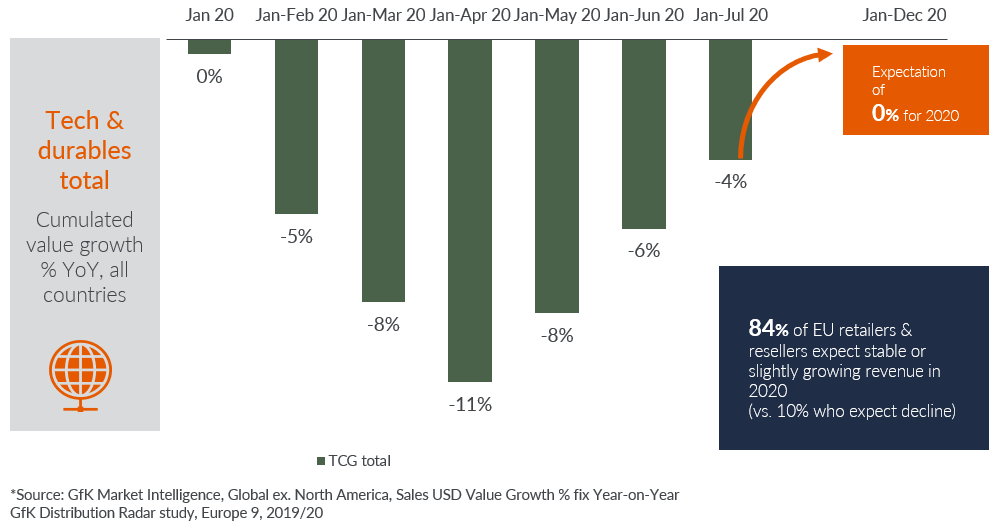Think back to just before the crisis. Economists were already talking about a potential recession. There was plenty to be concerned about – Brexit, various trade wars, a slowing global GDP. Then came COVID-19. The world went into lockdown, accelerating already prevalent trends in global markets.
The latest IMF forecasts indicate that the Global GDP growth rate is declining by 4.4%. Yet the story isn’t all bad. GfK Market Intelligence for the global technology and consumer goods industry reveals that the overall GDP growth rate is steadily stabilizing each month since May 2020. In fact, we may end up with a stagnant 0% technology and consumer goods growth rate for 2020.
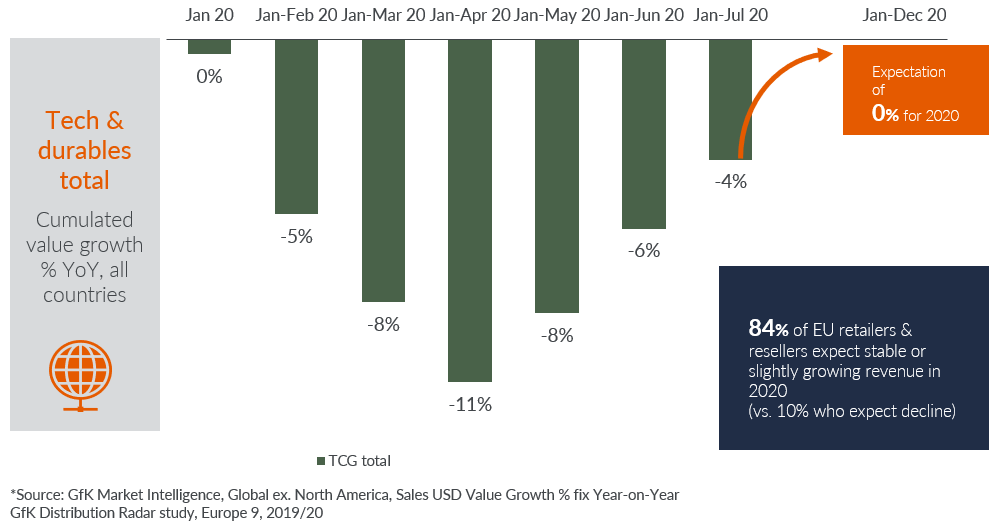
The resilience revealed in the tech and consumer goods industry is primarily powered by ‘At Home Experiences’ – eat at home, clean at home, work at home and entertain at home. These themes also form the basis of much of the accelerated disruption for this industry.
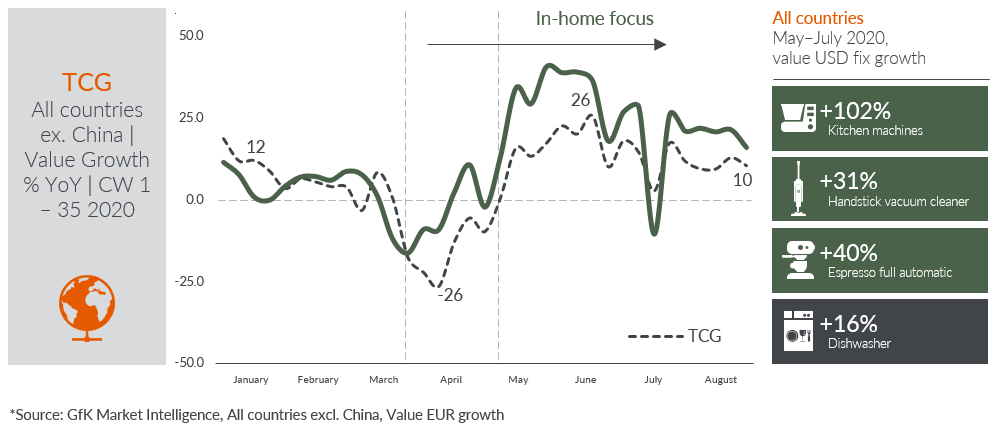
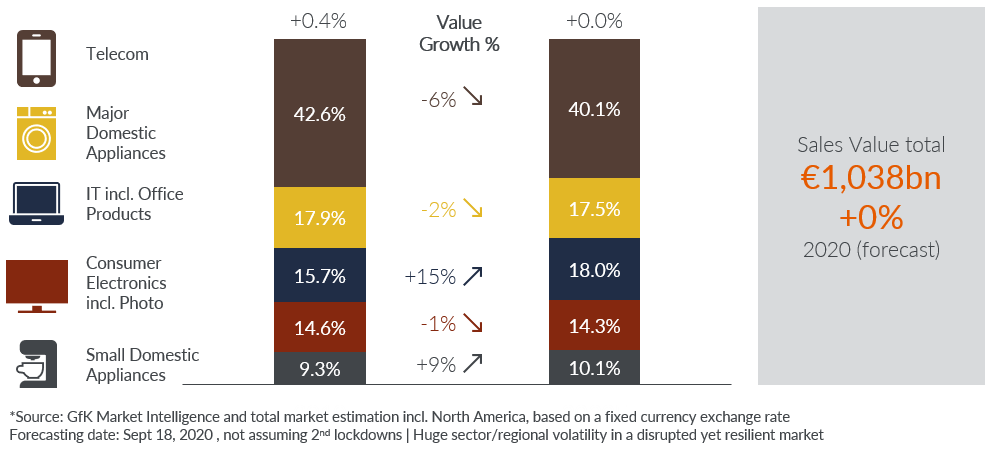
However, this is not the only pocket of opportunity. In these and other industries, companies that continue to innovate throughout a crisis, with the right tools and insights as guidance, can thrive in even the most disruptive environments. Those that thrive will come out on top.
After the last big recession, the Harvard Business Review set out to study which companies bounce back afterward. A team of researchers scoured the last three global recessions (the 1980 crisis, the 1990 slowdown, and the 2000 bust) looking for the magic formula of the companies that bounced back to pre-recession levels the fastest. Their findings? The most successful companies balanced selective cost cutting and investing in their future growth. The most successful companies in this group, which had a 37% higher probability of breaking from the pack, reduced costs by focusing on operational efficiency rather than by slashing the number of employees.
Often times, creating operational efficiency required companies to innovate – to find new technologies that help them get the job done faster, better, or more accurately than before. Our analysis shows how big of a factor innovation is in long term success. Taking learnings from the last global economic crisis in 2008/09, we saw that innovation in the form of continually launching new models and features enabled brands to gain traction and relevance with consumers.
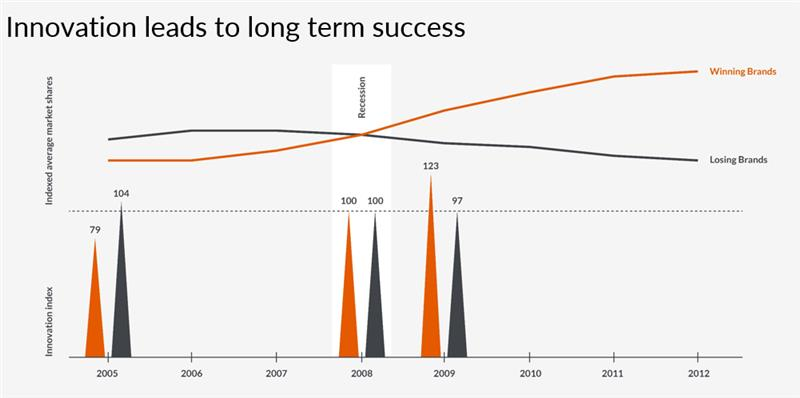
Turning data overload into your competitive edge
So, let’s talk about efficiencies, particularly when it comes to access to data. If you want a competitive edge, you can’t suffer from data overload. We no longer have the luxury of time to spend months analyzing data across disparate systems, and the unprecedented market conditions means relying on gut-feeling for the right strategies is more likely to crash your business than move it forward. What has worked in the past no longer works today thanks to the speed of ongoing change across the board: from consumer shopping behavior and decision making, to what your competitors are doing and how your business’s daily operations are being affected.
Thriving in this environment is only possible if you can equip your teams to make agile decisions – maybe even weekly – that are built on the latest market facts, and that they can implement immediately. Here at GfK, we practice what we preach, continuously reviewing our portfolio of marketing campaigns and brand activations and optimizing them weekly. We collaborate and adjust our go-to-market together with sales and product teams at the same frequency and speed. In order to do teams require access to always-on insights and expert recommendations from a single source. This has not always been easy to access – until now.
Therefore, many years ago GfK began to partner with top consumer brands and invest in technology to address this challenge – leveraging AI and analyzing trillions of data points to extract signal from the noise to enable companies to enhance their decision making.
Access to immediate intelligence of this type can support smarter, faster decisions to build efficiencies across your entire organization – from how and where you sell your product, to how you attract customers, optimize marketing and increase loyalty.
How and where you sell

More people are buying online. This trend has been on the rise for the last decade thanks to advances in technology, speedier logistics, and the rise of the convenience economy. The COVID-19 crisis has strengthened this trend, with the share of online sales growing throughout 2020, even when physical stores started to reopen. This trend will continue, with consumers stating that they plan to continue shopping online.
Click-and-mortar has clearly benefited from these trends – but playing omnichannel requires you to be nimble in adjusting pricing and promotions as the market or competitor landscape alters. Your business’s technology, supply chain, and operations must work together seamlessly. And, you must be always up to date on consumer and shopper behavior and shopping preferences. That said, by taking advantage of this approach, you can more efficiently sell your products and set your business up for higher revenues now and well into the future.
How you attract customers
Digital advertising is growing in influence. Social media and online ads have overtaken traditional marketing in their importance in driving purchasing decisions. There’s also been a bump in online research before making a purchase.
During lockdown, 43% of consumers report visiting a retailer’s website when researching which products to buy. This means that your website matters. It should offer an excellent user experience and deliver the right information at the right time so that there are no barriers along a consumer’s path to purchase.
A heavily digitized marketing strategy requires you to focus on new marketing channels so that you can meet consumers where they are looking for information and buying. It requires you to be agile with your advertising. You need to understand your customers’ path-to-purchase, and you need to know which channels drive the highest ROI. But it will pay off. You will reach the right people and influence them to buy at the right time in their customer journey.
In summary
To come out of this recession stronger than ever, you need to know how shopping habits are changing so that you can change your business strategies quickly. Being fast and building efficiencies will accelerate your recovery in this completely disrupted, unpredictable time. It is what separates successful companies from the rest, and it all starts with always-on insights and smart recommendations powered by technology.
Struggling with getting the right insights?
